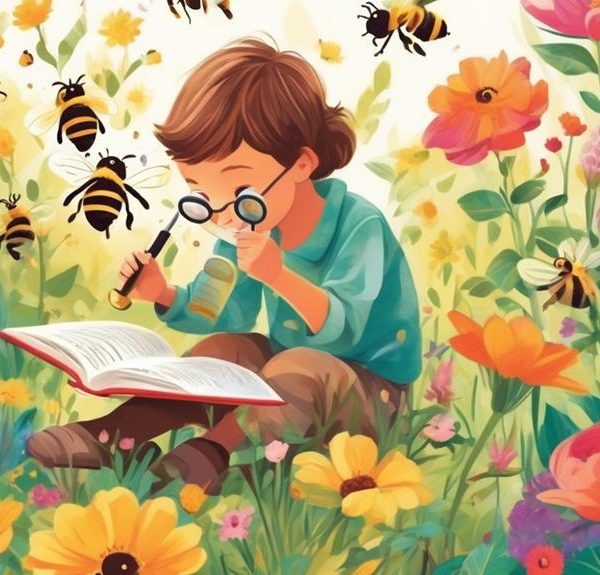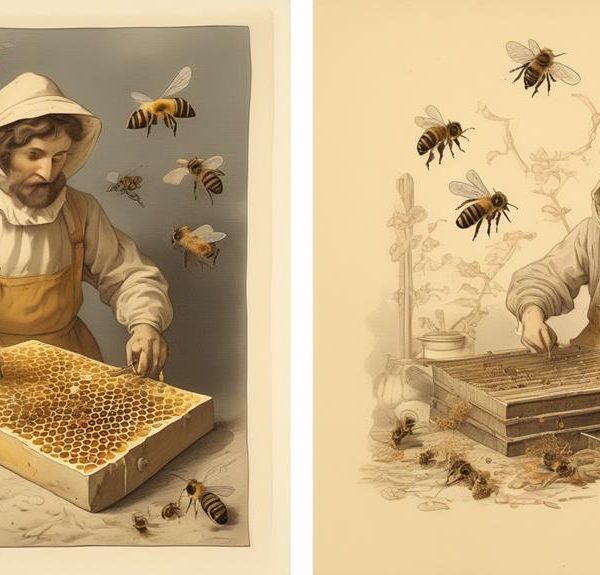Keeping you intrigued, discover the surprising timeline and intricate process of how bees bring honey from flower to table.
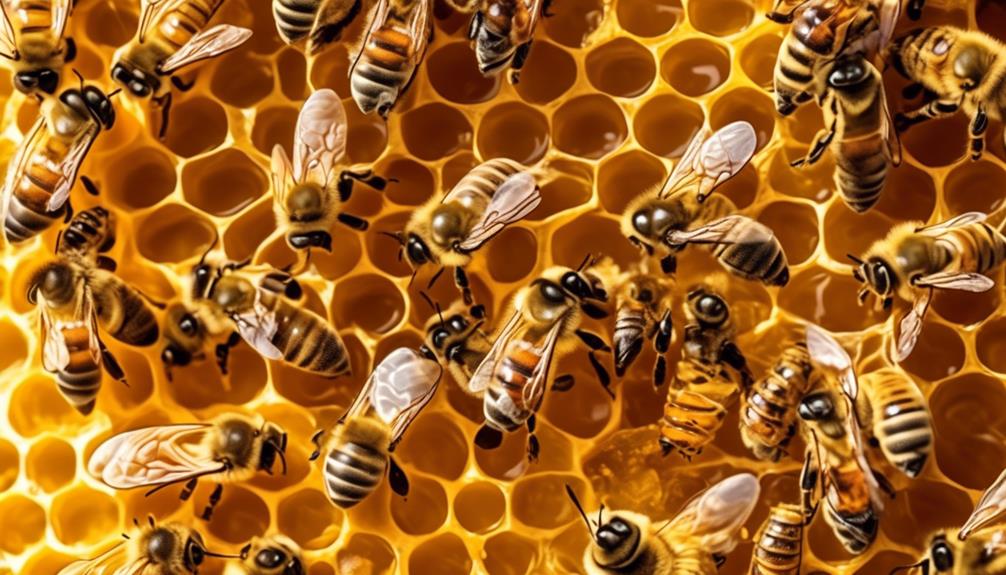
How Long Bees Take to Make Honey?
Imagine biting into a piece of toast slathered with sweet, golden honey. You're savoring not just a delicious breakfast, but the end result of an intricate and fascinating process undertaken by some of nature's most industrious creatures.
The journey from flower to beehive to your breakfast table is a complex one that involves numerous bees, each with a specific role to play. But have you ever stopped to wonder how long it actually takes for bees to make the honey you enjoy so much?
The answer might surprise you, and there's more to it than you might think.
Key Takeaways
- The honey production process involves bees foraging for nectar, breaking it down with enzymes, and depositing it in honeycomb cells.
- Bee roles in honey making include the queen laying eggs, worker bees collecting nectar, nurse bees tending to larvae and the queen, and younger worker bees converting nectar into honey.
- The time breakdown for honey creation includes around 20 minutes of in-hive processing of nectar and a drying process that can take a week or more.
- Factors such as the type of nectar source, weather conditions, and the size of the bee colony can influence the time it takes for honey production.
Understanding the Honey Production Process
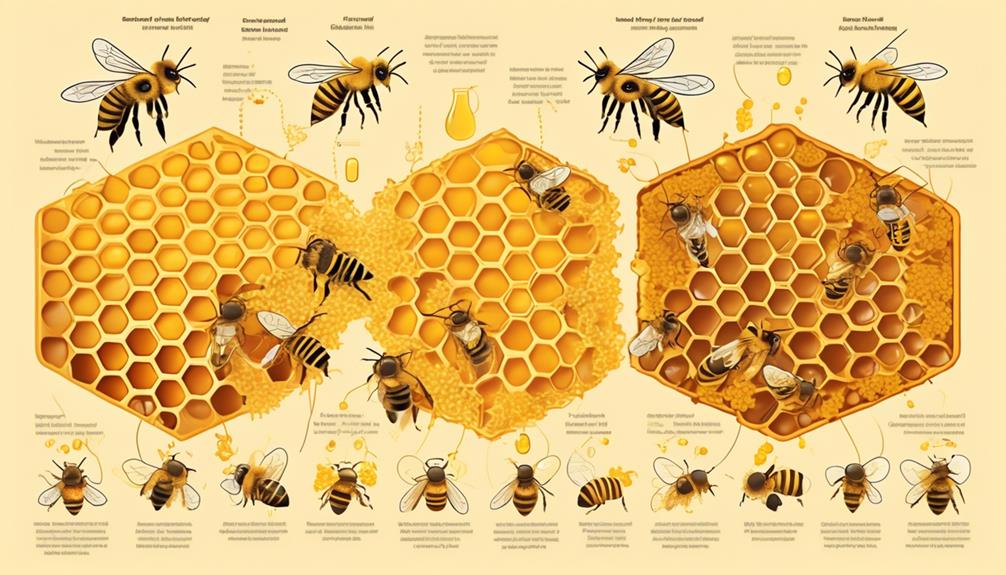
Delving into the intricacies of the honey production process, you'll find it's a complex, harmonious dance that bees meticulously orchestrate, transforming nectar into the sweet, golden elixir we know as honey.
The journey begins when worker bees, tasked with foraging, take flight in pursuit of flowers blooming with nectar. Once located, the bees extract nectar using their long, tube-shaped tongues and store it in their 'honey stomachs'. Intriguingly, enzymes in the bee's stomach begin the process of breaking down the complex sugars of the nectar into simpler ones, starting honey's transformation.
Upon returning to the hive, the forager bee regurgitates the nectar to a house bee. This bee continues the breakdown process by adding more enzymes and further reducing the water content. The resulting substance is deposited into a honeycomb cell and left to dry, often aided by bees fanning their wings to accelerate evaporation.
Bee Roles in Honey Making
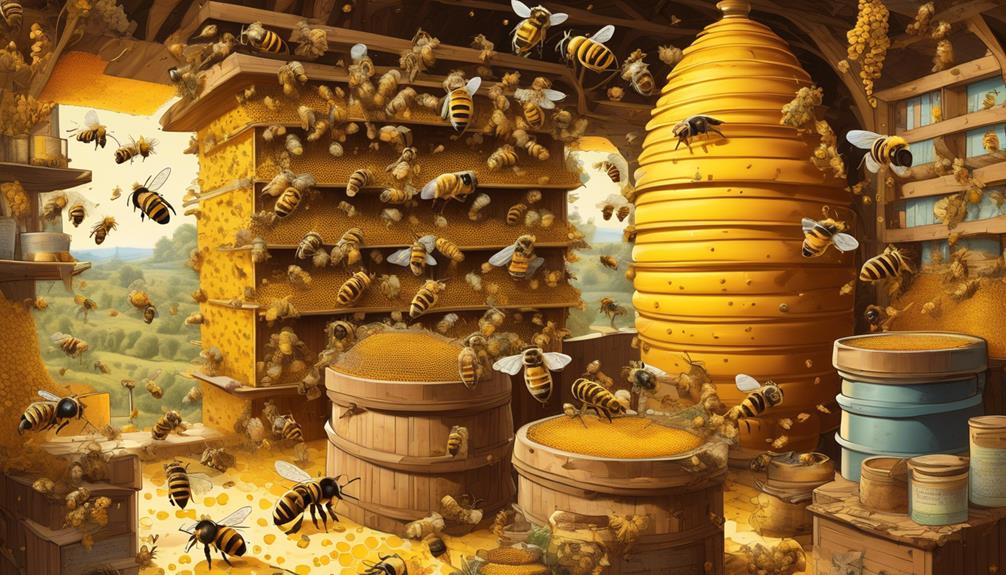
Building on this intricate process, it's crucial to appreciate the distinct roles that different bees play in the creation of honey. In each hive, you'll find three types of bees: the queen, workers, and drones.
The queen's primary role is to lay eggs, ensuring the continuity of the colony.
Meanwhile, worker bees are the real heroes of honey production. They begin their lives as nurse bees, feeding larvae and tending to the queen. After about a week, they graduate to become foragers. As foragers, they collect nectar and pollen from flowers, carrying them back to the hive in their honey stomachs.
Back at the hive, the nectar is transferred to younger worker bees. They then begin the process of converting this nectar into honey by adding enzymes and reducing the water content through evaporation.
Drones, the only males in the hive, aren't directly involved in honey making. Their primary function is to mate with the queen.
Understanding these roles, it's clear that honey making is a team effort, with each bee type playing a vital role in this complex, efficient, and awe-inspiring process.
Time Breakdown for Honey Creation
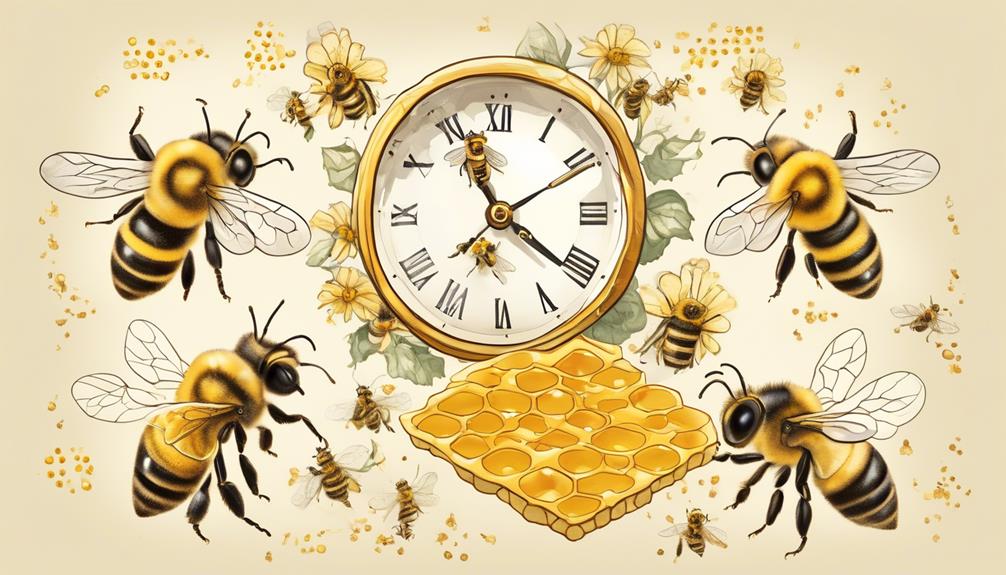
To fully grasp the intricacy of honey creation, it's essential to break down the timeline and understand just how long these diligent worker bees take to transform nectar into the sweet honey we enjoy. It's not an overnight task; there's a methodical process that takes place over weeks.
Once a worker bee finds a nectar source, it'll collect and store the nectar in its honey stomach. The bee then returns to the hive, regurgitates the nectar to another bee, which continues until the nectar is sufficiently processed. This in-hive processing takes around 20 minutes. The bees then deposit the processed nectar into the honeycomb cells and beat their wings, evaporating water and thickening the nectar into honey. This drying process can take a week or more.
In total, from nectar collection to the final honey product, it can take anywhere from a week to a month, depending on the type and quantity of nectar available. This is a testament to the laborious nature of honey production, reflecting the industrious character of these remarkable insects. Every drop of honey you enjoy is a product of countless hours of labor from these diligent workers.
Factors Influencing Honey Production Time
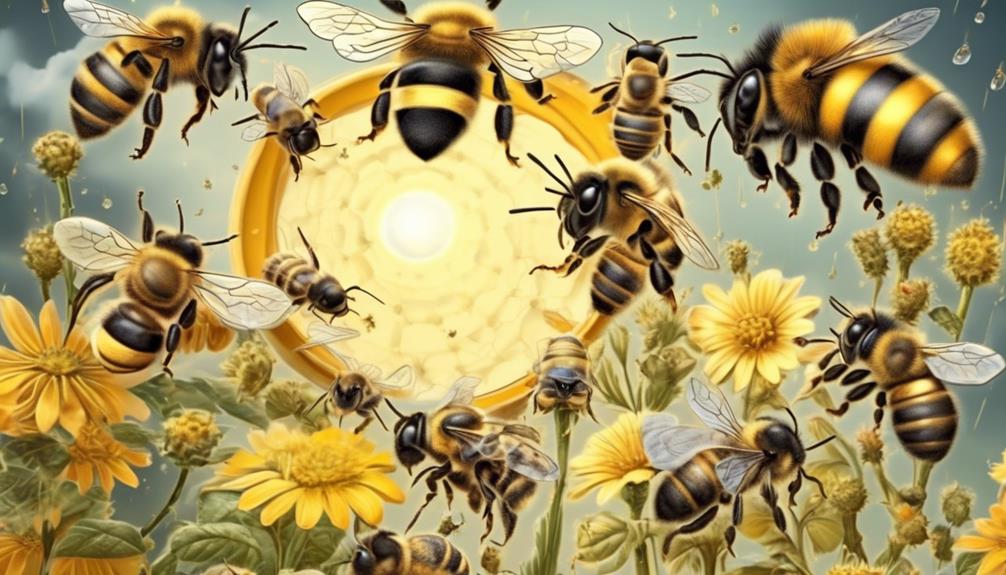
Several factors can influence the time it takes for bees to produce honey. The type of nectar source is critical. Different plants produce nectar with varying levels of sugar concentration. Plants with higher sugar concentration allow bees to produce honey faster because they don't have to work as hard to thicken the nectar into honey.
Weather conditions also play a significant role. Ideal conditions for honey production are warm, sunny, and dry. In these conditions, bees can forage more, and the nectar they collect dries out faster, speeding up honey production. On the other hand, rainy or cold weather can slow down the process dramatically. Bees can't forage efficiently, and the nectar takes longer to turn into honey.
The size of the bee colony matters too. Larger colonies can collect more nectar and therefore can produce honey faster. However, they also consume more honey for their survival. So, it's a delicate balance.
How Weather Affects Honey-Making
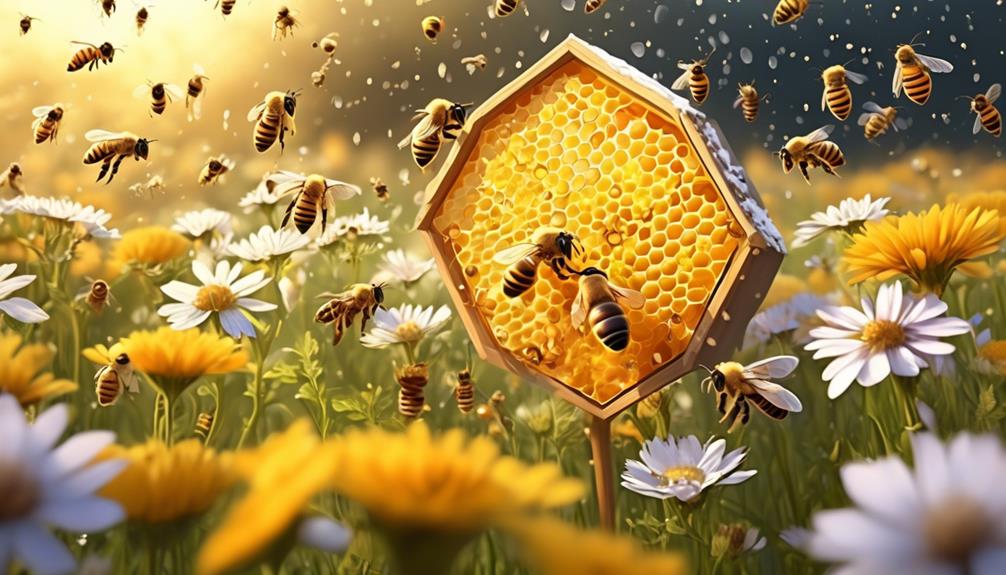
Imagine the sun beating down on a field of flowers, the air warm and dry – these are the perfect conditions for bees to make honey. Bees need warmth for efficient honey production. They can't fly when the temperature dips below 10°C, limiting their ability to gather nectar. Also, nectar production in flowers is best when the weather is warm, so a cold snap can hamper honey production.
But it's not just about warmth. The right amount of rainfall is crucial too. Too much rain, and the bees can't fly out to collect nectar. Not enough rain, and the flowers won't produce enough nectar. It's a delicate balance.
Wind speed also plays a part. High winds can make it difficult for bees to fly, reducing nectar collection.
Then there's humidity. Bees dry out the nectar to make honey, and high humidity slows down this process, delaying honey production.
In short, weather conditions significantly impact honey-making. They affect not just the bees' ability to collect nectar, but also the availability of nectar and the speed of honey production.
Frequently Asked Questions
What Are the Health Benefits of Honey Made by Bees?
Honey, produced by bees, is packed with health benefits. It's rich in antioxidants which help protect your body from cell damage due to free radicals. You'll find it's a natural remedy for coughs and aids in improving sleep. Its antibacterial properties can speed up wound healing too.
Moreover, it's a healthier alternative to sugar, helping control your blood sugar levels. So, incorporating honey into your diet could really boost your overall health.
Are There Different Types of Honey That Bees Can Produce?
Yes, there are various types of honey that bees can produce.
The type of honey produced mainly depends on the type of flowers the bees feed on. For instance, if bees feed on clover, they'll produce clover honey. Similarly, bees feeding on lavender flowers will produce lavender honey.
Each type of honey has a distinct taste, color, and aroma.
It's fascinating how versatile these tiny creatures are, isn't it?
How Can You Tell if Honey Is Pure or Adulterated?
To determine if honey is pure or adulterated, you'll need to perform a few tests.
Try the thumb test: place a small drop on your thumb. If it spreads or spills, it's not pure.
In the water test, add a spoonful to a glass of water. Pure honey will settle at the bottom, while adulterated honey will dissolve.
Lastly, light a match near it. If it lights, it's pure honey as impure honey contains moisture that prevents ignition.
What Is the Impact on the Bee Population Due to Honey Production?
Honey production can impact the bee population in several ways. Overharvesting can leave colonies without enough food for winter, causing starvation. Pesticides used on crops bees pollinate can also harm them.
However, responsible beekeeping practices, like leaving enough honey for bees and avoiding harmful chemicals, can help sustain healthy populations.
How Does Honey Harvesting Affect the Ecosystem and Biodiversity?
Honey harvesting can significantly impact the ecosystem and biodiversity.
When you harvest honey excessively, you're not only depriving bees of their food, but also disrupting their natural behavior. This can lead to a decline in bee populations, which play a crucial role in pollination.
Fewer bees mean fewer pollinated plants, resulting in reduced biodiversity.
Therefore, sustainable honey harvesting is essential to maintain balance in our ecosystems.
Conclusion
So, you've discovered the intricacy of honey production.
It's a lengthy process, isn't it? From busy worker bees collecting nectar, to the transformation into honey, it can take weeks. Remember, factors like the type of flowers and weather greatly influence the time.
Understanding this process deepens your appreciation for every drop of honey and the tireless bees that produce it.
So next time you enjoy honey, remember the complex, natural process behind its creation.

